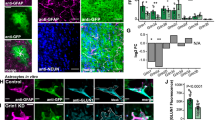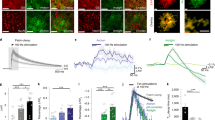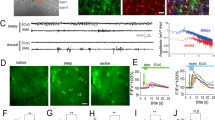Abstract
Intracellular Ca2+ signaling is considered to be important for multiple astrocyte functions in neural circuits. However, mice devoid of inositol triphosphate type 2 receptors (IP3R2) reportedly lack all astrocyte Ca2+ signaling, but display no neuronal or neurovascular deficits, implying that astrocyte Ca2+ fluctuations are not involved in these functions. An assumption has been that the loss of somatic Ca2+ fluctuations also reflects a similar loss in astrocyte processes. We tested this assumption and found diverse types of Ca2+ fluctuations in astrocytes, with most occurring in processes rather than in somata. These fluctuations were preserved in Ip3r2−/− (also known as Itpr2−/−) mice in brain slices and in vivo, occurred in end feet, and were increased by G protein–coupled receptor activation and by startle-induced neuromodulatory responses. Our data reveal previously unknown Ca2+ fluctuations in astrocytes and highlight limitations of studies that used Ip3r2−/− mice to evaluate astrocyte contributions to neural circuit function and mouse behavior.
This is a preview of subscription content, access via your institution
Access options
Subscribe to this journal
Receive 12 print issues and online access
$209.00 per year
only $17.42 per issue
Buy this article
- Purchase on Springer Link
- Instant access to full article PDF
Prices may be subject to local taxes which are calculated during checkout








Similar content being viewed by others
References
Bushong, E.A., Martone, M.E., Jones, Y.Z. & Ellisman, M.H. Protoplasmic astrocytes in CA1 stratum radiatum occupy separate anatomical domains. J. Neurosci. 22, 183–192 (2002).
Wilhelmsson, U. et al. Redefining the concept of reactive astrocytes as cells that remain within their unique domains upon reaction to injury. Proc. Natl. Acad. Sci. USA 103, 17513–17518 (2006).
Attwell, D. et al. Glial and neuronal control of brain blood flow. Nature 468, 232–243 (2010).
Barres, B.A. The mystery and magic of glia: a perspective on their roles in health and disease. Neuron 60, 430–440 (2008).
Khakh, B.S. & McCarthy, K.D. Astrocyte calcium signals: from observations to functions and the challenges therein. Cold Spring Harb. Perspect. Biol. published online, 10.1101/cshperspect.a020404 (20 Jan 2015).
Cornell-Bell, A.H., Finkbeiner, S.M., Cooper, M.S. & Smith, S.J. Glutamate induces calcium waves in cultured astrocytes: long-range glial signaling. Science 247, 470–473 (1990).
Allen, N.J. Astrocyte regulation of synaptic behavior. Annu. Rev. Cell Dev. Biol. 30, 439–463 (2014).
Halassa, M.M. & Haydon, P.G. Integrated brain circuits: astrocytic networks modulate neuronal activity and behavior. Annu. Rev. Physiol. 72, 335–355 (2010).
Petravicz, J., Fiacco, T.A. & McCarthy, K.D. Loss of IP3 receptor-dependent Ca2+ increases in hippocampal astrocytes does not affect baseline CA1 pyramidal neuron synaptic activity. J. Neurosci. 28, 4967–4973 (2008).
Agulhon, C., Fiacco, T.A. & McCarthy, K.D. Hippocampal short- and long-term plasticity are not modulated by astrocyte Ca2+ signaling. Science 327, 1250–1254 (2010).
Agulhon, C. et al. Modulation of the autonomic nervous system and behaviour by acute glial cell Gq protein-coupled receptor activation in vivo. J. Physiol. (Lond.) 591, 5599–5609 (2013).
Zhang, Y. et al. An RNA-Sequencing transcriptome and splicing database of glia, neurons, and vascular cells of the cerebral cortex. J. Neurosci. 34, 11929–11947 (2014).
Petravicz, J., Boyt, K.M. & McCarthy, K.D. Astrocyte IP3R2-dependent Ca(2+) signaling is not a major modulator of neuronal pathways governing behavior. Front. Behav. Neurosci. 8, 384 (2014).
Nizar, K. et al. In vivo stimulus-induced vasodilation occurs without IP3 receptor activation and may precede astrocytic calcium increase. J. Neurosci. 33, 8411–8422 (2013).
Takata, N. et al. Cerebral blood flow modulation by Basal forebrain or whisker stimulation can occur independently of large cytosolic Ca2+ signaling in astrocytes. PLoS ONE 8, e66525 (2013).
Bonder, D.E. & McCarthy, K.D. Astrocytic Gq-GPCR-linked IP3R-dependent Ca2+ signaling does not mediate neurovascular coupling in mouse visual cortex in vivo. J. Neurosci. 34, 13139–13150 (2014).
Takata, N. et al. Astrocyte calcium signaling transforms cholinergic modulation to cortical plasticity in vivo. J. Neurosci. 31, 18155–18165 (2011).
Chen, N. et al. Nucleus basalis–enabled stimulus-specific plasticity in the visual cortex is mediated by astrocytes. Proc. Natl. Acad. Sci. USA 109, E2832–E2841 (2012).
Navarrete, M. et al. Astrocytes mediate in vivo cholinergic-induced synaptic plasticity. PLoS Biol. 10, e1001259 (2012).
Perez-Alvarez, A., Navarrete, M., Covelo, A., Martín, E.D. & Araque, A. Structural and functional plasticity of astrocyte processes and dendritic spine interactions. J. Neurosci. 34, 12738–12744 (2014).
Wang, F. et al. Astrocytes modulate neural network activity by Ca2+-dependent uptake of extracellular K+. Sci. Signal. 5, ra26 (2012).
Chen, T.W. et al. Ultrasensitive fluorescent proteins for imaging neuronal activity. Nature 499, 295–300 (2013).
Shigetomi, E. et al. Imaging calcium microdomains within entire astrocyte territories and end feet with GCaMPs expressed using adeno-associated viruses. J. Gen. Physiol. 141, 633–647 (2013).
Haustein, M.D. et al. Conditions and constraints for astrocyte calcium signaling in the hippocampal mossy fiber pathway. Neuron 82, 413–429 (2014).
Jiang, R., Haustein, M.D., Sofroniew, M.V. & Khakh, B.S. Imaging intracellular Ca2+ signals in striatal astrocytes from adult mice using genetically-encoded calcium indicators. J. Vis. Exp. published online, 10.3791/51972 (19 November 2014).
Sun, W. et al. Glutamate-dependent neuroglial calcium signaling differs between young and adult brain. Science 339, 197–200 (2013).
Nimmerjahn, A., Mukamel, E.A. & Schnitzer, M.J. Motor behavior activates Bergmann glial networks. Neuron 62, 400–412 (2009).
Thrane, A.S. et al. General anesthesia selectively disrupts astrocyte calcium signaling in the awake mouse cortex. Proc. Natl. Acad. Sci. USA 109, 18974–18979 (2012).
Paukert, M. et al. Norepinephrine controls astroglial responsiveness to local circuit activity. Neuron 82, 1263–1270 (2014).
Ding, F. et al. α1-Adrenergic receptors mediate coordinated Ca(2+) signaling of cortical astrocytes in awake, behaving mice. Cell Calcium 54, 387–394 (2013).
Fiacco, T.A. et al. Selective stimulation of astrocyte calcium in situ does not affect neuronal excitatory synaptic activity. Neuron 54, 611–626 (2007).
Reeves, A.M., Shigetomi, E. & Khakh, B.S. Bulk loading of calcium indicator dyes to study astrocyte physiology: key limitations and improvements using morphological maps. J. Neurosci. 31, 9353–9358 (2011).
Fiacco, T.A., Agulhon, C. & McCarthy, K.D. Sorting out astrocyte physiology from pharmacology. Annu. Rev. Pharmacol. Toxicol. 49, 151–174 (2009).
Shigetomi, E., Bowser, D.N., Sofroniew, M.V. & Khakh, B.S. Two forms of astrocyte calcium excitability have distinct effects on NMDA receptor-mediated slow inward currents in pyramidal neurons. J. Neurosci. 28, 6659–6663 (2008).
Anders, S. et al. Spatial properties of astrocyte gap junction coupling in the rat hippocampus. Philos. Trans. R Soc. Lond. B Biol. Sci. 369, 20130600 (2014).
Wallraff, A. et al. The impact of astrocytic gap junctional coupling on potassium buffering in the hippocampus. J. Neurosci. 26, 5438–5447 (2006).
Nett, W.J., Oloff, S.H. & McCarthy, K.D. Hippocampal astrocytes in situ exhibit calcium oscillations that occur independent of neuronal activity. J. Neurophysiol. 87, 528–537 (2002).
Otsu, Y. et al. Calcium dynamics in astrocyte processes during neurovascular coupling. Nat. Neurosci. 18, 210–218 (2015).
Shigetomi, E., Kracun, S., Sofroniew, M.V. & Khakh, B.S. A genetically targeted optical sensor to monitor calcium signals in astrocyte processes. Nat. Neurosci. 13, 759–766 (2010).
Panatier, A. et al. Astrocytes are endogenous regulators of basal transmission at central synapses. Cell 146, 785–798 (2011).
Di Castro, M.A. et al. Local Ca2+ detection and modulation of synaptic release by astrocytes. Nat. Neurosci. 14, 1276–1284 (2011).
Bekar, L.K., He, W. & Nedergaard, M. Locus coeruleus alpha-adrenergic-mediated activation of cortical astrocytes in vivo. Cereb. Cortex 18, 2789–2795 (2008).
Polack, P.O., Friedman, J. & Golshani, P. Cellular mechanisms of brain state–dependent gain modulation in visual cortex. Nat. Neurosci. 16, 1331–1339 (2013).
Wang, F., Xu, Q., Wang, W., Takano, T. & Nedergaard, M. Bergmann glia modulate cerebellar Purkinje cell bistability via Ca2+-dependent K+ uptake. Proc. Natl. Acad. Sci. USA 109, 7911–7916 (2012).
Shigetomi, E., Tong, X., Kwan, K.Y., Corey, D.P. & Khakh, B.S. TRPA1 channels regulate astrocyte resting calcium and inhibitory synapse efficacy through GAT-3. Nat. Neurosci. 15, 70–80 (2012).
Muthukumar, A.K., Stork, T. & Freeman, M.R. Activity-dependent regulation of astrocyte GAT levels during synaptogenesis. Nat. Neurosci. 17, 1340–1350 (2014).
Shigetomi, E., Jackson-Weaver, O., Huckstepp, R.T., O'Dell, T.J. & Khakh, B.S. TRPA1 channels are regulators of astrocyte basal calcium levels and long-term potentiation via constitutive D-serine release. J. Neurosci. 33, 10143–10153 (2013).
Fossat, P. et al. Glial D-serine gates NMDA receptors at excitatory synapses in prefrontal cortex. Cereb. Cortex 22, 595–606 (2012).
Madisen, L. et al. Transgenic mice for intersectional targeting of neural sensors and effectors with high specificity and performance. Neuron 85, 942–958 (2015).
Pologruto, T.A., Sabatini, B.L. & Svoboda, K. ScanImage: flexible software for operating laser scanning microscopes. Biomed. Eng. Online 2, 13 (2003).
Acknowledgements
The authors are grateful to current and past members of the laboratories for discussions and comments. Thanks also to M.V. Sofroniew for sharing equipment and to J. Chen for sharing mice. Special thanks to M.D. Haustein who helped with the initial testing of GECIquant and made valuable suggestions on its development. We thank C. Octeau for comments on the paper. Most of the work was supported by the US National Institutes of Health (NIH, NS060677). B.S.K., R.S. and S.V. were also supported by NIH grants (MH099559A, MH104069) and the CHDI Foundation. P.G. and B.S.H. were supported by NIH MH101198-1 and a Simon's Foundation Circuits Grant.
Author information
Authors and Affiliations
Contributions
R.S. carried out the molecular biology, hippocampal stereotaxic injections and most of the slice experiments with help from A.D.J. and H.C. B.S.H. performed all of the cortical virus injections and cranial window implantations for the in vivo experiments. B.S.H. and R.S. did the in vivo imaging together. S.V. wrote the GECIquant software and R.S. tested it. P.G. shared expertise on in vivo calcium imaging. H.Z. made and shared GCaMP6f knock-in mice. R.S. and B.S.K. analyzed data. B.S.K. directed the experiments, assembled the figures and wrote the paper. All of the authors contributed to the final version.
Corresponding author
Ethics declarations
Competing interests
The authors declare no competing financial interests.
Integrated supplementary information
Supplementary Figure 1 Unbiased semi-automated Ca2+ fluctuationdetection within astrocytes using GECIquant.
a. Schematic showing the sequence of steps involved in isolating the objects of interest. The confocal t-stack (left) is represented as a series of x-y frames with time t as the third dimension and the pixel intensities are given by I(x,y,t) for 0 ≤ x < imagewidth, 0 ≤ y < imageheight, and, 0 < t ≤ stacklength. As a first step, the t-stack is reduced to a two-dimensional maximum intensity projection image (middle) with I (x,y)max representing the maximum intensities at each x-y pixel coordinate of the t-stack. This image is thresholded to generate a binary image (right) to isolate the objects I(x,y)thresh (black) from background (white). b-d. Pixel operations involved in each of the above steps. For background subtraction, I(t)avg_bck is the average of n pixel intensities in a user selected area at a given time frame t and I(x,y,t)total represents the raw pixel intensities before background subtraction. For object thresholding, AO and AB refer to averages of object and background pixels respectively and T is the threshold intensity estimated using an iterative algorithm (Isodata) in ImageJ. e. Shows the steps involved in object tracing. The resulting object’s area is calculated by summing the areas of all the pixels (1:Np) covered by the detected object as given by the object area equation, where Wp and Hp represent the pixel width and height respectively in microns. f. Pixel calculation for ROI centroids is given in the equationwhere, Xk, Yk is the centroid of the kth ROI, (xi, yi) are the pixel coordinates of the kth ROI, NP is the number of pixels in the ROI and M represents the total number of ROI. Pixel calculation for the Euclidean distance between two ROI centroids are shown in equation (ii) where, Xreference, Yreference represents the centroid of the reference somatic ROI. g. Representative maximum projection image of a hippocampal astrocyte expressing GCaMP6f from a 300 s movie. This image was subjected to semi-automated data analyses using GECIquant, which separated somatic, wave and microdomain compartments.
Supplementary Figure 2 Testing ofGECIquant to measure the size of fluorescent beads.
Fluorescence images of 4 and 1 μm diameter beads (white) (Tetraspeck fluorescent microspheres size kit, Life Technologies catalog number T14792) along with their semi-automated detection images from GECIquant (red). All the beads were reliably detected and the measured areas of the beads in cross section were almost identical to the calculated areas, as shown in the graph.
Supplementary Figure 3 Testing ofGECIquant to draw around cellular shapes.
Fluorescence image of bovine pulmonary artery endothelial cells (Molecular Devices Fluocells prepared Slide Set catalog number F36924), which were subjected to semi-automated rendering with GECIquant (yellow). The program faithfully captured much of the complexity and accurately outlined the cells and their shapes, as shown in the black-and-white image and in the line profile graph across a region of the cell.
Supplementary Figure 4 Testing ofGECIquant to detect blinking quantum dots.
For the panels on the left, the distance scale bars represent 10 μm. Image of quantum dots acquired with a CCD camera. The lower image shows that each dot was faithfully captured as an ROI with GECIquant. A selection of these dots (in red) was used to generate plots of their intensity over time (traces in red). Clear fluctuations in quantum dot intensity due to blinking behavior were detected using GECIquant. The details of the quantum dots and imaging conditions have been reported already (Richler, E., Shigetomi, E. & Khakh, B. S. 2011 J Neurosci 31, 16716-16730).
Supplementary Figure 8 Studies with GCaMP6fflx mice crossed with GLAST-Cre/ERT2 mice.
a. Cartoon of the experiment, whereby GCaMP6fflx mice (JAX #024105) were crossed with GLAST-Cre/ERT2 mice. The GCaMP6fflx mice were donated to JAX by Dr. Hongkui Zeng (Allen Institute for Brain Sciences). All of the information on the genetics and genotyping is available at JAX by searching online for the mouse identification number, 024105. b. Two representative images of GCaMP6f immuno expression (green) in relation to S100β. GCaMP6f was expressed in ~40% of S100β positive astrocytes and of these ~33% were isolated from other GCaMP6f expressing astrocytes. We exploited this feature to image isolated astrocytes like that shown in c. The traces for astrocyte shown in c are shown on the right.
Supplementary Figure 9 Average data for Ca2+ fluctuation frequencies for somatic fluctuations as well as fluctuations in processes (waves and microdomains).
We analyzed the frequency of the three types of fluctuations using our original data set (Fig 1 of paper) and for isolated astrocytes from AAV2/5 microinjections (Supplementary Fig. 7) and from GCaMP6fflx mice (Supplementary Fig. 8). The frequencies were not statistically different for any type of fluctuation across these three data sets, indicating that our original data set (Fig. 1) contained an undetectable number of Ca2+ fluctuations from adjacent GCaMP6f expressing astrocytes (see Main text for details).
Supplementary Figure 10 Traces and average data for waves and microdomains from astrocyte processes from WT mice before, during and after applications of nominally Ca2+ free buffer.
These data are for ROIs that did not show changes upon applying Ca2+ free buffers. Data are from the same cells depicted in Fig. 3 of the main manuscript but are from regions in these cells that did not show changes in fluctuation frequency in Ca2+ free buffers. Data for regions that did show changes in fluctuation frequency in Ca2+ free buffers are shown in Fig 3 of the paper.
Supplementary Figure 11 Summary data for startle-evoked Ca2+ fluctuations in cortical astrocyte somata and processes showing a persistent late component in IP3R2–/–astrocyte processes.
a. The bar graphs show data at the indicated time epochs relative to baseline from experiments such as those shown in Fig. 7. The mice were startled at 225 s. Graphs are shown for WT and IP3R2–/– mice. b. As in a, but for data gathered from processes. The P value listed above each bar indicates the result of statistical comparison of that data set with the baseline period. The statistical test employed was a paired non-parametric Mann-Whitney test.
Supplementary information
Supplementary Text and Figures
Supplementary Figures 1–11 and Supplementary Tables 1 and 2 (PDF 858 kb)
Supplementary Code
GECIquant code and instructions (PDF 1807 kb)
41593_2015_BFnn4001_MOESM118_ESM.avi
Representative movie for endothelin-evoked Ca2+ fluctuations in hippocampal astrocytes from Ip3r2-/- mice. (AVI 46045 kb)
41593_2015_BFnn4001_MOESM120_ESM.avi
Representative movie for spontaneous Ca2+ fluctuations in cortical astrocytes in vivo from Ip3r2-/- mice. (AVI 17588 kb)
41593_2015_BFnn4001_MOESM121_ESM.wmv
Representative movie for behavioral startle response of a WT mouse in response to an air puff to the face. (WMV 1481 kb)
41593_2015_BFnn4001_MOESM123_ESM.avi
Representative movie for startle-evoked Ca2+ fluctuations in cortical astrocytes in vivo from WT mice after administration of prazosin. (AVI 44444 kb)
Rights and permissions
About this article
Cite this article
Srinivasan, R., Huang, B., Venugopal, S. et al. Ca2+ signaling in astrocytes from Ip3r2−/− mice in brain slices and during startle responses in vivo. Nat Neurosci 18, 708–717 (2015). https://doi.org/10.1038/nn.4001
Received:
Accepted:
Published:
Issue Date:
DOI: https://doi.org/10.1038/nn.4001
This article is cited by
-
Cortical astrocyte N-methyl-D-aspartate receptors influence whisker barrel activity and sensory discrimination in mice
Nature Communications (2024)
-
Synaptic input and Ca2+ activity in zebrafish oligodendrocyte precursor cells contribute to myelin sheath formation
Nature Neuroscience (2024)
-
SIGAA: signaling automated analysis: a new tool for Ca2+ signaling quantification using ratiometric Ca2+ dyes
Signal, Image and Video Processing (2024)
-
Adenosine-independent regulation of the sleep–wake cycle by astrocyte activity
Cell Discovery (2023)
-
Norepinephrine modulates calcium dynamics in cortical oligodendrocyte precursor cells promoting proliferation during arousal in mice
Nature Neuroscience (2023)



